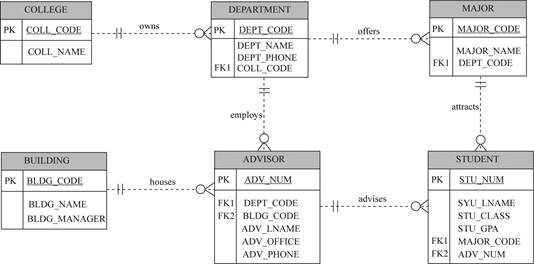
Concept explainers
a.
Normalization:
The process used to minimize data redundancy and dependency in a relational
Second normal form (2NF):
- The value of all non-primary key attributes should be dependent on the primary key attribute.
- If any attribute is depending on the partial primary key then it should determine the other attributes for an instance of the entity.
- The partial dependencies should be removed from the data model.
Third normal form (3NF):
- The value of any non-primary key attributes will not depend on any other non-primary key attributes.
- If any non-primary key attributes depend on any other non-primary key attribute then it should be moved or deleted.
- It is termed as transitive dependency.
Partial dependency:
A partial dependency exists at that time of an attributes depends only a part of primary key. This dependency is related with 1st normal form.
Transitive dependency:
A transitive dependency exists at that time of an attributes depends on another attribute which is not part of primary key.
Functional dependency:
An association between two attributes or two set of attributes in a same relational database table, which is having some constraints is known as functional dependency.
- In a table one attribute is functionally dependent on another attribute to take one value.
a.
Explanation of Solution
Construct the dependency diagram with all partial and transitive dependencies:
The relational schema for given STUDENT table is given below:
STUDENT(STU_NUM, STU_LNAME, STU_MAJOR, DEPT_CODE, DEPT_NAME,
DEPT_PHONE, ADVISOR_LNAME, ADVISOR_OFFICE, ADVISOR_BLDG, ADVISOR_PHONE, STU_GPA, STU_HOURS, STU_CLASS)
- Here, “STU_NUM” indicates the primary key.
The representation of dependency diagram with all transitive dependencies is shown below:

Explanation:
In the above dependency diagram,
- The transitive dependency is,
DEPT_CODE -> (DEPT_NAME, DEPT_PHONE, COLLEGE_NAME)
ADV_OFFICE -> (ADV_BUILDINGS)
STU_HOURS -> (STU_CLASS)
b.
Normalization:
The process used to minimize data redundancy and dependency in a relational database is known as normalization. The database table is divided into two or more tables and defines the relationship between those tables.
Second normal form (2NF):
- The value of all non-primary key attributes should be dependent on the primary key attribute.
- If any attribute is depending on the partial primary key then it should determine the other attributes for an instance of the entity.
- The partial dependencies should be removed from the data model.
Third normal form (3NF):
- The value of any non-primary key attributes will not depend on any other non-primary key attributes.
- If any non-primary key attributes depend on any other non-primary key attribute then it should be moved or deleted.
- It is termed as transitive dependency.
Partial dependency:
A partial dependency exists at that time of an attributes depends only a part of primary key. This dependency is related with 1st normal form.
Transitive dependency:
A transitive dependency exists at that time of an attributes depends on another attribute which is not part of primary key.
Functional dependency:
An association between two attributes or two set of attributes in a same relational database table, which is having some constraints is known as functional dependency.
- In a table one attribute is functionally dependent on another attribute to take one value.
b.
Explanation of Solution
Construct the dependency diagram:
The new dependency diagram is represented by removing all transitive dependencies in STUDENT table.
First table:
The relational schema for first table is given below:
STUDENT(STU_NUM, STU_LNAME, STU_MAJOR, DEPT_CODE, ADVISOR_NUM STU_GPA, STU_HOURS, STU_CLASS)
- Here, “STU_NUM” indicates the primary keys and “ADVISOR_NUM” indicates the foreign key.
- The relation is in third normal form (2NF), since there is transitive dependency in this table.
The representation of dependency diagram in first table is shown below:

Second table:
The relational schema for second table is given below:
MAJOR(MAJOR_CODE, DEPT_CODE, MAJOR_DESCRIPTION)
- Here, “MAJOR_CODE” indicates the primary key.
- The relation is in third normal form (3NF), since there is no transitive dependency and no repeated attributes.
The representation of dependency diagram in second table is shown below:

Third table:
The relational schema for third table is given below:
BUILDING(BLDG_CODE, BLDG_NAME, BLDG_MANAGER)
- Here, “BLDG_CODE” indicates the primary key.
- The relation is in third normal form (3NF), since there is no transitive dependency and no repeated attributes.
The representation of dependency diagram in third table is shown below:

Fourth table:
The relational schema for fourth table is given below:
DEPARTMENT(DEPT_NAME, DEPT_PHONE, COLL_CODE)
- Here, “DEPT_NAME” indicates the primary key.
- The relation is in third normal form (3NF) but it does not meet the BCNF, since there is no transitive dependency and no repeated attributes.
The representation of dependency diagram in fourth table is shown below:

Fifth table:
The relational schema for fifth table is given below:
COLLEGE(COLL_CODE, COLL_NAME)
- Here, “COLL_CODE” indicates the primary key.
- The relation is in third normal form (3NF), since there is no transitive dependency and no repeated attributes.
The representation of dependency diagram in fifth table is shown below:

Sixth table:
The relational schema for sixth table is given below:
ADVISOR(ADV_NUM, ADV_LASTNAME, ADV_OFFICE, ADV_BUILDING, ADV_PHONE)
- Here, “ADV_NUM” indicates the primary key.
- The dotted transitive dependency line specifies that dependency is interpretation.
- The relation is in third normal form (2NF), since there is transitive dependency in this table.
The representation of dependency diagram in sixth table is shown below:

c.
Explanation of Solution
The representation of Crow’s Foot Entity Relational Diagram (ERD) is shown below:
The following data model shows the solution for the given question.

Explanation:
- In the above data model, the college owns more than one department.
- The “COLLEGE” entity contains the “COLL_CODE” and “COLL_NAME” attributes.
- The primary key of “COLL_CODE” entity is “INV_NUM”.
- The “DEPARTMENT” entity contains the “DEPT_CODE”, “DEPT_NAME”, “DEPT_PHONE” and “COLL_CODE” attributes.
- The primary of this entity is “DEPT_CODE”.
- The foreign key of this entity is “COLL_CODE”.
- The “COLLEGE” entity contains the “COLL_CODE” and “COLL_NAME” attributes.
- The department offers more than one major.
- The “MAJOR” entity contains the “MAJOR_CODE”, “MAJOR_NAME”, and “DEPT_CODE” attributes.
- The primary key of “MAJOR_CODE” for this entity.
- The foreign key of this entity is “VEND_CODE”.
- The “MAJOR” entity contains the “MAJOR_CODE”, “MAJOR_NAME”, and “DEPT_CODE” attributes.
- The major attracts more than one student.
- The “STUDENT” entity contains the “STU_NUM”, “STU_LNAME”, “STU_CLASS”, “STU_HOURS”, “STU_GPA”, “MAJOR_CODE”, and “ADV_NUM” attributes.
- The primary key of “STU_NUM” entity.
- The foreign key of this entity is “MAJOR_CODE” and “ADV_NUM”.
- The “STUDENT” entity contains the “STU_NUM”, “STU_LNAME”, “STU_CLASS”, “STU_HOURS”, “STU_GPA”, “MAJOR_CODE”, and “ADV_NUM” attributes.
- The building houses more than one advisor.
- The “ADVISOR” entity contains the “ADV_NUM”, “DEPT_CODE”, “BLDG_CODE”, “ADV_LNAME”, “ADV_OFFICE”, and “ADV_PHONE” attributes.
- The primary key of “ADV_NUM” entity.
- The foreign key of this entity is “DEPT_CODE” and “BLDG_CODE”.
- The “BUILDING” entity contains the “BLDG_CODE”, “BLDG_NAME” and “BLDG_MANAGER” attributes.
- The primary key of “BLDG_CODE” entity.
- The “ADVISOR” entity contains the “ADV_NUM”, “DEPT_CODE”, “BLDG_CODE”, “ADV_LNAME”, “ADV_OFFICE”, and “ADV_PHONE” attributes.
- The advisor advises more than one student.
Want to see more full solutions like this?
Chapter 6 Solutions
Database Systems + Mindtap Mis, 6-month Access
- Using the INVOICE table structure shown in Table P6.3, do the following: a. Write the relational schema, draw its dependency diagram, and identify all dependencies, including all partial and transitive dependencies. You can assume that the table does not contain repeating groups and that an invoice number references more than one product. (Hint: This table uses a composite primary key.)b. Remove all partial dependencies, write the relational schema, and draw the new dependency diagrams. Identify the normal forms for each table structure you created.Note: You can assume that any given product is supplied by a single vendor, but a vendor can supply many products. Therefore, it is proper to conclude that the following dependency exists:PROD_NUM S PROD_lABEl, PROD_PRICE, vEND_CODE, vEND_NAME(Hint: Your actions should produce three dependency diagrams.)c. Remove all transitive dependencies, write the relational schema, and draw the new dependency diagrams. Also identify the normal forms for…arrow_forwardUsing the INVOICE table structure shown in table P6.3, do the following a. Write the relational schema, draw its dependency diagram, and identify all dependencies, including all partial and transitive dependencies. You can assume that the table does not contain repeating groups and that an invoice number references more than one product. (Hint: This table uses a composite primary key.) b.Remove all partial dependencies, write the relational schema, and draw the new dependency diagrams. Identify the normal forms for each table structure you created. Note You can assume that any given product is supplied by a single vendor, but a vendor can supply many products. Therefore, it is proper to conclude that the following dependency exists: PROD_NUM -+ PROD_LABEL, PROD_PRICE,VEND_CODE, VEND_NAME ( Hint Your actions should produce three dependency diagrams.) c. Remove all transitive dependencies, write the relational schema, and draw the new dependency diagrams. Also, identify the normal…arrow_forward
 A Guide to SQLComputer ScienceISBN:9781111527273Author:Philip J. PrattPublisher:Course Technology Ptr
A Guide to SQLComputer ScienceISBN:9781111527273Author:Philip J. PrattPublisher:Course Technology Ptr Database Systems: Design, Implementation, & Manag...Computer ScienceISBN:9781305627482Author:Carlos Coronel, Steven MorrisPublisher:Cengage Learning
Database Systems: Design, Implementation, & Manag...Computer ScienceISBN:9781305627482Author:Carlos Coronel, Steven MorrisPublisher:Cengage Learning Database Systems: Design, Implementation, & Manag...Computer ScienceISBN:9781285196145Author:Steven, Steven Morris, Carlos Coronel, Carlos, Coronel, Carlos; Morris, Carlos Coronel and Steven Morris, Carlos Coronel; Steven Morris, Steven Morris; Carlos CoronelPublisher:Cengage Learning
Database Systems: Design, Implementation, & Manag...Computer ScienceISBN:9781285196145Author:Steven, Steven Morris, Carlos Coronel, Carlos, Coronel, Carlos; Morris, Carlos Coronel and Steven Morris, Carlos Coronel; Steven Morris, Steven Morris; Carlos CoronelPublisher:Cengage Learning


